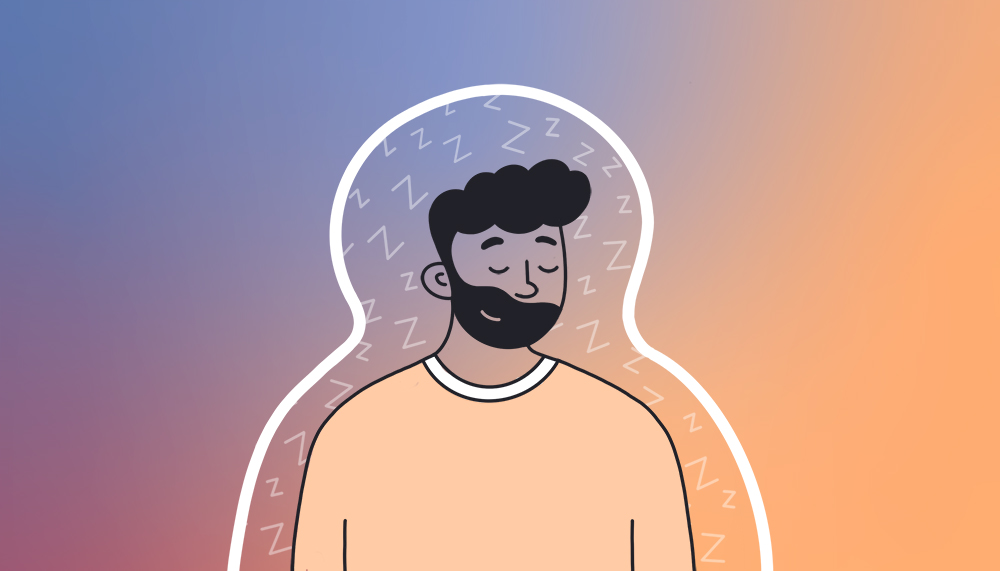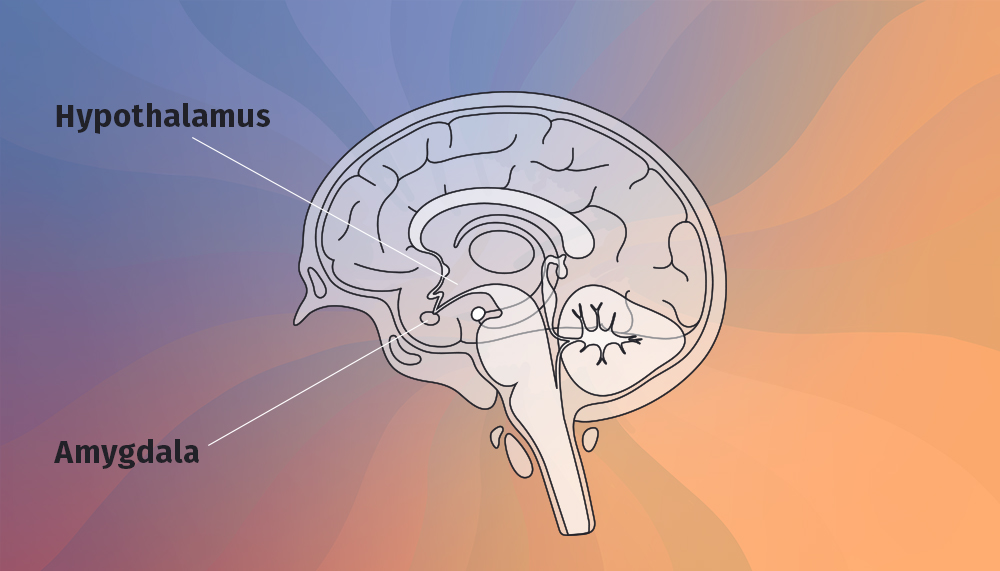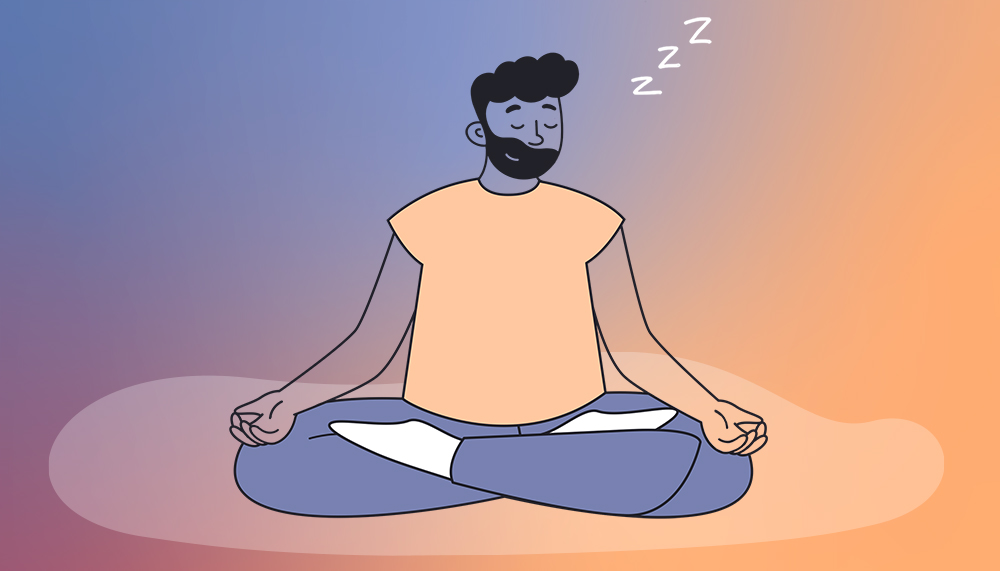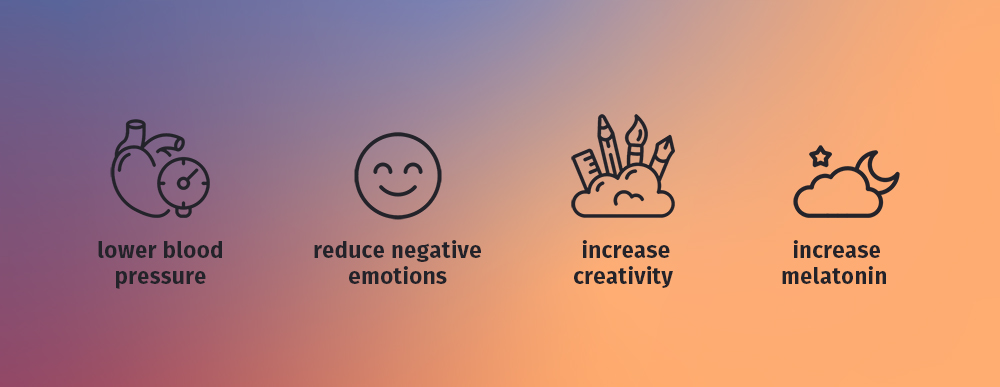When you think of meditation, you may think of expert yogis, your therapist who’s always preaching about mindfulness techniques, or that one friend who just seems to have it all together. The result is that meditation can seem totally inaccessible to the rest of us, who maybe aren’t so great at taking a deep breath and letting go of our worries.
The good news is that meditation is not nearly as intimidating as you might think! Meditation is about helping build up the parts of your brain that allow you to observe your thoughts and feelings without judgment. Eventually, that may help you feel more enlightened, or more present, in your day-to-day life. But even in the short term (think ten minutes a day for a week), meditation can help reduce anxiety and stress. Meditation for sleep can also help you fall asleep faster and sleep more soundly through the night.
There are many different meditation techniques out there, so you can choose what works best for your life. Plus, a lot of resources are free and easily accessible with the internet, apps, or YouTube, so you can try a lot of different things before deciding what works. And while that might end up being something traditional like a bi-weekly yoga practice (yoga and meditation experts are actually full of great sleep and relaxation tips), it could also be something as simple as three minutes of deep breathing in the morning.
Read on below to learn more about how meditation can improve both sleep and mental health. Or skip to the end of this guide for some tips on practicing three popular types of meditation: guided meditation, mindfulness meditation, and mantra meditation.

Mindful Meditation for Sleep
Sleep deprivation can lead to increased fatigue, worsened symptoms of depression and anxiety, and generally reduced quality of life. And many people struggle with sleep. In fact, 50% of older adults (people over age 55) struggle with sleep issues. While severe sleep disorders like insomnia are often treated with medication, moderate sleep problems (like taking a long time to fall asleep at night or waking up often during the night) are often left untreated. Luckily, a regular meditation practice can really improve your sleep quality. Whether you’re just looking to get better sleep or are trying to address serious issues like sleep deprivation and insomnia, a regular meditation practice can help you wake up feeling more well-rested.
Meditating has several sleep-related benefits. First off, it can make it easier to let go of worries and fall asleep faster. It has also been shown to improve the quality of your sleep, and can potentially help you get more deep sleep at night. Beyond that, it also has several health benefits. Getting enough sleep can lower your risk of heart disease, diabetes, and other chronic illnesses. It can also improve your memory and mental clarity, boost your immune system, and even help you implement better eating habits!
So, how exactly does meditation improve your sleep? Physically, it invokes a “relaxation response” in your body that helps ease stress and related ailments like high blood pressure. That relaxation response can help increase melatonin, which promotes feelings of sleepiness. Mentally, practicing meditation regularly during the day can make it easier for you to calm your nervous system and wind down at night, which makes it easier to fall asleep fast. This skill will also make it easier to fall back to sleep if you wake up in the middle of the night, which is key to helping some people get a good night’s sleep.
Sold on meditation as a sleep aid? Just wait until you learn what it can do for your mental health!

Meditation for Mental Health
One of the most praised benefits of meditation is the way it can improve your mental health. People love meditation because it can increase feelings of well-being, help with anxiety and depression, and help them live in the present moment. Read on below to learn more about how meditation can help with anxiety, stress, and depression.
Can meditation help anxiety?
Certain meditation techniques can help manage anxiety. Specifically, clinical trials have shown that mindfulness meditation can reduce symptoms of anxiety and depression, and can even help reduce the number of panic attacks some people have. Mindfulness meditation is also particularly helpful for people with social anxiety.
Wondering how this works? Anxiety occurs when your brain is unable to control your emotional responses to perceived threats. Mindfulness meditation can stop your brain from overreacting to those threats. This practice actively trains your brain in order to help you recenter in the present, which can stop you from spiraling into anxiety. In fact, mindfulness meditation is so helpful for anxiety that over 82% of therapists use mindfulness practices with their patients.
Can meditation help stress?
Yes! Much like it can improve anxiety, meditation is a great stress-reliever. In fact, mindfulness meditation specifically decreases cell volume in the areas of your brain that create fear and stress. This leads to lower stress levels over time. Even if you’re a beginner who can only meditate for a short time, meditation can be a great stress reliever. In fact, meditating for just 13 minutes per day can reduce symptoms of stress.
Can meditation help depression?
Meditation (especially mindfulness meditation) can also help with depression. One study found that sustained mindfulness meditation had as much of a positive effect on patients as antidepressants. When you’re depressed, your brain’s medial prefrontal cortex and amygdala are overactive. Meditation helps stop these two areas of your brain from playing off of each other to make you feel depressed. It also actually increases the volume of gray matter in your brain’s hippocampus. People with depression tend to have smaller hippocampuses, so growing this portion of your brain through sustained meditation can help you regulate your symptoms.

How to Practice Meditation
Sold on meditating but not sure how to get started? We’ve got you covered! Read on below to learn about basic meditation techniques. Meditation is about finding a technique that works for you. The most important thing to do when you start meditating is find a technique that you’re able to stick to. While there are many different types of meditation you can try, all of them require:
- Focused attention. This can be especially hard for beginners, but your focus will improve over time! Things like visualization or guided meditation apps can be especially helpful for improving this skill.
- Relaxed breathing. Most meditation techniques involve basic breathing exercises that will help you calm down and center yourself.
- A quiet setting. You’ll want a distraction-free, comfortable space to meditate.
- A comfortable position. Working on focusing and clearing your mind while you’re hunched over or uncomfortable is very difficult. Make things easier for yourself by stretching out on your bed or sitting upright in a comfortable chair. If you’re on the hunt for an extra relaxing place to meditate, check out our best organic mattresses guide.
- An open attitude. Meditation will not work if you’re not open to it being difficult at first. Start your practice knowing you won’t always achieve the calm, clear focus you’re hoping for. Training your brain through meditation is like training any muscle, so it will take time and practice. Try to stay open to the process and avoid getting frustrated with yourself.
Guided meditation
Guided meditation is often based on visualizations. Your teacher, or a meditation app like Calm or Headspace will help you focus on forming mental images of places or situations you find relaxing. Visualization can include imagining sights, sounds, smells, and textures. A lot of people especially like using guided meditations like this to fall asleep. For instance, Headspace’s sleepcasts are guided meditations in the form of soothing podcasts that help you drift off to sleep.
Other common guided meditations include body scans (which direct you to focus on each part of your body) and walking meditations (that give you things to focus on while taking a walk). If guided meditation sounds interesting to you, you can check out some different guided sleep meditation apps here. You can also check out a list of free guided meditations on YouTube here.
Mindfulness meditation
Mindfulness meditation is meant to help increase your awareness and acceptance of the present moment. Practitioners learn different breathing methods and techniques in order to be more aware of what they are experiencing in the moment of their meditation. This technique is meant to allow you to observe your thoughts and emotions, but let them pass without focusing on them. Eventually, this can make it easier to allow negative thoughts and emotions pass even when you are not meditating.
Body scans, guided meditations, affirmations, and mantras can all be used in mindfulness meditation practice. To check out some beginner resources, take a look at Ethan Green’s guide or these resources. Mindfulness is also great for children, and it can be easier to start young, just like any skill. If you’re interested in practicing mindfulness with the entire family, take a look at the resources on this page.
If you’re looking for something you can try right now, try this five finger breathing exercise to get you started.
This exercise is great for beginners, because it incorporates breath, touch, and sight! Having so much to focus on can help you get out of your head and focus on the task at hand. Some meditators like to do this process with their eyes closed, and that works too. You can always modify a meditation technique to make it work better for you.
Mantra meditation
Finally, let’s talk about mantra meditation. Normally, this involves silently repeating a calming word or phrase as you meditate to help you stay focused and in the present. It also helps keep you from getting lost in your thoughts as you meditate. The classic example of mantra meditation is the “ohm” sound, but there are plenty of other mantras you can choose from! For instance, you can use an entire phrase, like “Let it be.”
If you’re interested in mantra meditation, consider trying some of the mantras found here. If you like mantra meditation, you might also like meditation music. Like you would focus on your mantra, you focus on the rise and fall of relaxing music (or sometimes a relaxing sound like a chime) to help you relax or drift off to sleep. If you’re interested, Spotify has a peaceful meditation playlist you can try here.

Positive Effects of Meditation
As discussed above, meditation can have many positive effects, especially if you practice it consistently over a long period of time. Some of the most prominent positive effects of meditation are:
- Lower blood pressure and heart rate
- Reduced stress and negative emotions
- Increased self awareness, creativity, and patience
- Increased melatonin and serotonin levels
While meditation is good for everyone, it can be especially helpful for folks who suffer from certain conditions. If you need extra tools to manage your moods, need to reduce stress to manage a medical condition, or because you suffer from pain, meditation is a great tool to have in your toolbox. Take a look at the list below to see some conditions that meditation (and especially mindfulness meditation) can be especially helpful for:
- Anxiety
- Chronic pain
- Depression
- Heart disease
- High blood pressure
- IBS
- Sleep conditions
- Tension headaches
Final Thoughts
Meditation can help improve your sleep and reduce anxiety and depression. It’s a great way for anyone to improve their quality of life, and we highly recommend giving it a try. But remember, if you really want to improve your sleep, you also need to practice good sleep hygiene. This includes sticking to a sleep schedule, avoiding electronics before bed, and sleeping in a dark and quiet room.
References:
- https://www.health.harvard.edu/blog/mindfulness-meditation-helps-fight-insomnia-improves-sleep-201502187726
- https://jamanetwork.com/journals/jamainternalmedicine/fullarticle/2110998
- https://jamanetwork.com/journals/jamainternalmedicine/fullarticle/1809754
- https://www.ncbi.nlm.nih.gov/pmc/articles/PMC3328970/
- https://www.ncbi.nlm.nih.gov/pmc/articles/PMC3004979/
- https://www.sciencedirect.com/science/article/abs/pii/016383439500025M

